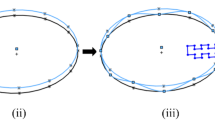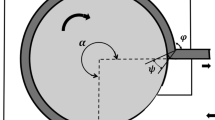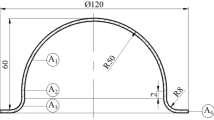Abstract
In contact mechanics analysis, load, deformation, friction, and residual stress are important variables that need to be considered to understand the behavior of materials under contact for application in biomedical industry. This study investigated the effect of load, diameter ratio, and friction coefficient on the contact behavior between two hemispheres of equal hardness. The finite element method (FEM) used in this study incorporated variations in load (2500 N, 5000 N, and 8000 N) and friction coefficient (0, 0.05, 0.1, 0.4, 0.8) to detect the impact of these factors on residual stress and deformation springback in the diameter ratio ranging from 1 to 5. The upper hemisphere had a constant diameter, while the diameter of the bottom hemisphere was varied according to the chosen diameter ratio. The results showed that an increase in the diameter ratio caused a decrease in the deformation ratio, indicating that smaller hemispheres experienced an increase in deformation. The study also found that the model showing springback will decrease with increasing load and diameter ratio. The load and diameter ratio affected the springback and residual stress of the hemispheres. Large loads led to reduced springback and high residual stress. Higher diameter ratios resulted in lower springback and wider residual stress distribution in the bottom hemisphere and reduced residual stress distribution in the upper hemisphere. The friction coefficient also affected the residual stress distribution. Therefore, appropriate load, diameter ratio, and friction coefficient selection are crucial factors for producing high-quality products in biomedical industry.








Similar content being viewed by others
References
N. Shaikh, B.S. Shenoy, N.S. Bhat, and S. Shetty, Wear Estimation at the Contact Surfaces of Oval Shaped Hip Implants Using Finite Element Analysis, Cogent Eng., 2023, 10(1), p 2222985. https://doi.org/10.1080/23311916.2023.2222985
H. Hertz, Ueber Die Berührung Fester Elastischer Körper, J. Reine Angew. Math., 1882, 1882(92), p 156–171.
W.R. Chang, I. Etsion, and D.B. Bogy, An Elastic-Plastic Model for the Contact of Rough Surfaces, J. Tribol., 1987, 109(2), p 257–263. https://doi.org/10.1115/1.3261348
Y. Zhao, D.M. Maietta, and L. Chang, An Asperity Microcontact Model Incorporating the Transition from Elastic Deformation to Fully Plastic Flow, J. Tribol., 2000, 122(1), p 86–93. https://doi.org/10.1115/1.555332
L. Kogut and I. Etsion, Elastic-Plastic Contact Analysis of a Sphere and a Rigid Flat, J. Appl. Mech. Trans. ASME, 2002, 69(5), p 657–662. https://doi.org/10.1115/1.1490373
R.L. Jackson and I. Green, A Finite Element Study of Elasto-Plastic Hemispherical Contact against a Rigid Flat, J. Tribol., 2005, 127(2), p 343–354. https://doi.org/10.1115/1.1866166
S. Shankar and M.M. Mayuram, Effect of Strain Hardening in Elastic-Plastic Transition Behavior in a Hemisphere in Contact with a Rigid Flat, Int. J. Solids Struct., 2008, 45(10), p 3009–3020. https://doi.org/10.1016/j.ijsolstr.2008.01.017
M.R. Brake, An Analytical Elastic-Perfectly Plastic Contact Model, Int. J. Solids Struct., 2012, 49(22), p 3129–3141. https://doi.org/10.1016/j.ijsolstr.2012.06.013
J. Jamari and D.J. Schipper, Deterministic Repeated Contact of Rough Surfaces, Wear, 2008, 264(3–4), p 349–358. https://doi.org/10.1016/j.wear.2007.03.024
B. Zhou, H. Cui, H. Liu, Y. Li, G. Liu, S. Li, and S. Zhang, Experimental Investigation and Finite Element Analysis on Fatigue Behavior of Aluminum Alloy 7050 Single-Lap Joints, J. Mater. Eng. Perform., 2018, 27(3), p 915–923. https://doi.org/10.1007/s11665-018-3137-9
G. Vastola, G. Zhang, Q.X. Pei, and Y.W. Zhang, Controlling of Residual Stress in Additive Manufacturing of Ti6Al4V by Finite Element Modeling, Addit. Manuf., 2016, 12, p 231–239. https://doi.org/10.1016/j.addma.2016.05.010
C.R. Liu and X. Yang, The Scatter of Surface Residual Stresses Produced by Face-Turning and Grinding, Mach. Sci. Technol., 2001, 5(1), p 1–21. https://doi.org/10.1081/MST-100103175
X. Yang, C.R. Liu, and A.F. Grandt, An Experimental Study on Fatigue Life Variance, Residual Stress Variance, and Their Correlation of Face-Turned and Ground Ti 6Al-4V Samples, J. Manuf. Sci. Eng., 2002, 124(4), p 809–819. https://doi.org/10.1115/1.1511174
K. Wang, Y. Wang, X. Yue, and W. Cai, Multiphysics Modeling and Uncertainty Quantification of Tribocorrosion in Aluminum Alloys, Corros. Sci., 2020, 2021(178), p 109095. https://doi.org/10.1016/j.corsci.2020.109095
O. Iracheta, C.J. Bennett, and W. Sun, A Sensitivity Study of Parameters Affecting Residual Stress Predictions in Finite Element Modelling of the Inertia Friction Welding Process, Int. J. Solids Struct., 2015, 71, p 180–193. https://doi.org/10.1016/j.ijsolstr.2015.06.018
J. Zhao, J. Tang, W. Zhou, T. Jiang, H. Liu, and B. Xing, Numerical Modeling and Experimental Verification of Residual Stress Distribution Evolution of 12Cr2Ni4A Steel Generated by Shot Peening, Surf. Coatings Technol., 2022, 430, p 127993. https://doi.org/10.1016/j.surfcoat.2021.127993
K. Sherafatnia, G.H. Farrahi, A.H. Mahmoudi, and A. Ghasemi, Experimental Measurement and Analytical Determination of Shot Peening Residual Stresses Considering Friction and Real Unloading Behavior, Mater. Sci. Eng. A, 2016, 657, p 309–321. https://doi.org/10.1016/j.msea.2016.01.070
F. Nazari, M. Honarpisheh, and H. Zhao, Effect of the Uncertainty of Multi-Cut Contour Method and Friction Coefficient on Residual Stresses of Constrained Groove Pressing Process, Proc. Inst. Mech. Eng. Part C J. Mech. Eng. Sci., 2021, 235(11), p 2039–2052. https://doi.org/10.1177/0954406220948908
R. Jackson, I. Chusoipin, and I. Green, A Finite Element Study of the Residual Stress and Deformation in Hemispherical Contacts, J. Tribol., 2005, 127(3), p 484–493. https://doi.org/10.1115/1.1843166
T. Jana, A. Mitra, and P. Sahoo, Unloading Analysis of Elastically and Plastically Graded Hemispherical Contact with Rigid Flat, Tribol. Int., 2020, 142, p 105973. https://doi.org/10.1016/j.triboint.2019.105973
Y. Kadin, Y. Kligerman, and I. Etsion, Multiple Loading-Unloading of an Elastic-Plastic Spherical Contact, Int. J. Solids Struct., 2006, 43(22–23), p 7119–7127. https://doi.org/10.1016/j.ijsolstr.2006.03.006
Z. Song and K. Komvopoulos, An Elastic-Plastic Analysis of Spherical Indentation: Constitutive Equations for Single-Indentation Unloading and Development of Plasticity Due to Repeated Indentation, Mech. Mater., 2014, 76, p 93–101. https://doi.org/10.1016/j.mechmat.2014.05.005
S. Zhou, X. Huang, W. Wu, and Y. Yang, Effect of Residual Stress in Surface Layer on Plastic Yield Inception, Appl. Sci., 2022, 12(22), p 11415. https://doi.org/10.3390/app122211415
P. Chakraborty and S.B. Prasad-Vejendla, Deformation and Annealing of Brass, Mater. Today Proc., 2022, 64, p 1380–1383. https://doi.org/10.1016/j.matpr.2022.04.502
D. Nocetti, K. Villalobos, N. Marín, M. Monardes, B. Tapia, M.I. Toledo, and C. Villegas, Radiation Dose Reduction and Image Quality Evaluation for Lateral Lumbar Spine Projection, Heliyon, 2023, 9(9), p 19509. https://doi.org/10.1016/j.heliyon.2023.e19509
O.D. Gonçalves, M. Egito, C. Castro, S. Groisman, M. Basílio, and N.L. da Penha, About the Elemental Analysis of Dental Implants, Radiat. Phys. Chem., 2019, 154, p 53–57. https://doi.org/10.1016/j.radphyschem.2018.03.014
B. van Straten, B. Tantuo, J. Dankelman, N.H. Sperna-Weiland, B.J. Boersma, and T. Horeman, Reprocessing Zamak Laryngoscope Blades into New Instrument Parts; an ‘All-in-One’ Experimental Study, Heliyon, 2022, 8(11), p 11711. https://doi.org/10.1016/j.heliyon.2022.e11711
M.D.P. Lamura, T. Hidayat, M.I. Ammarullah, A.P. Bayuseno, and J. Jamari, Study of Contact Mechanics between Two Brass Solids in Various Diameter Ratios and Friction Coefficient, Proc. Inst. Mech. Eng. Part J J. Eng. Tribol., 2023 https://doi.org/10.1177/14657503221144810
D. Sheng, K.D. Eigenbrod, and P. Wriggers, Finite Element Analysis of Pile Installation Using Large-Slip Frictional Contact, Comput. Geotech., 2005, 32, p 17–26. https://doi.org/10.1016/j.compgeo.2004.10.004
L. Fratini, S. Lo-Casto, and E. Lo-Valvo, A Technical Note on an Experimental Device to Measure Friction Coefficient in Sheet Metal Forming, J. Mater. Process. Technol., 2006, 172(1), p 16–21. https://doi.org/10.1016/j.jmatprotec.2005.08.008
B. Kaftanoglu, Determination of Coefficient of Friction Under Conditions of Deep-Drawing and Stretch Forming, Wear, 1973, 25(2), p 177–188. https://doi.org/10.1016/0043-1648(73)90070-7
A.K. Ghosh, A Method for Determining the Coefficient of Friction in Punch Stretching of Sheet Metals, Int. J. Mech. Sci., 1977, 19(8), p 457–470. https://doi.org/10.1016/0020-7403(77)90019-4
J.A. Bailey, Friction in Metal Machining-Mechanical Aspects, Wear, 1975, 31(2), p 243–275. https://doi.org/10.1016/0043-1648(75)90161-1
S. Sulaiman, M.K.A.M. Ariffin, and S.Y. Lai, Springback Behaviour in Sheet Metal Forming for Automotive Door, AASRI Procedia, 2012, 3, p 224–229. https://doi.org/10.1016/j.aasri.2012.11.037
S.A. Mohamad, A.M.E. Ahmed, and X. Lu, Influence of Macro-Scale Cylinder Liner Partial Surface Texturing on the Tribological Behavior of Two-Stroke Marine Diesel Engine Piston Ring, J Adv Res Fluid Mech Therm Sci, 2023, 101(2), p 111–120. https://doi.org/10.37934/arfmts.101.2.111120
Acknowledgments
This work was supported by the Ministry of Education, Culture, Research and Technology of the Republic of Indonesia through a scholarship of Master Education Program Leading to Doctoral Degree for Excellent Graduates (PMDSU) [Grant Number: 345-44/UN7.D2/PP/IV/2023].
Author information
Authors and Affiliations
Corresponding author
Additional information
Publisher's Note
Springer Nature remains neutral with regard to jurisdictional claims in published maps and institutional affiliations.
This invited article is part of a special topical issue of the Journal of Materials Engineering and Performance on Residual Stress Analysis: Measurement, Effects, and Control. The issue was organized by Rajan Bhambroo, Tenneco, Inc.; Lesley Frame, University of Connecticut; Andrew Payzant, Oak Ridge National Laboratory; and James Pineault, Proto Manufacturing on behalf of the ASM Residual Stress Technical Committee.
Rights and permissions
Springer Nature or its licensor (e.g. a society or other partner) holds exclusive rights to this article under a publishing agreement with the author(s) or other rightsholder(s); author self-archiving of the accepted manuscript version of this article is solely governed by the terms of such publishing agreement and applicable law.
About this article
Cite this article
Lamura, M.D.P., Ammarullah, M.I., Maula, M.I. et al. The Effect of Load, Diameter Ratio, and Friction Coefficient on Residual Stress in a Hemispherical Contact for Application in Biomedical Industry. J. of Materi Eng and Perform (2024). https://doi.org/10.1007/s11665-024-09330-9
Received:
Revised:
Accepted:
Published:
DOI: https://doi.org/10.1007/s11665-024-09330-9




